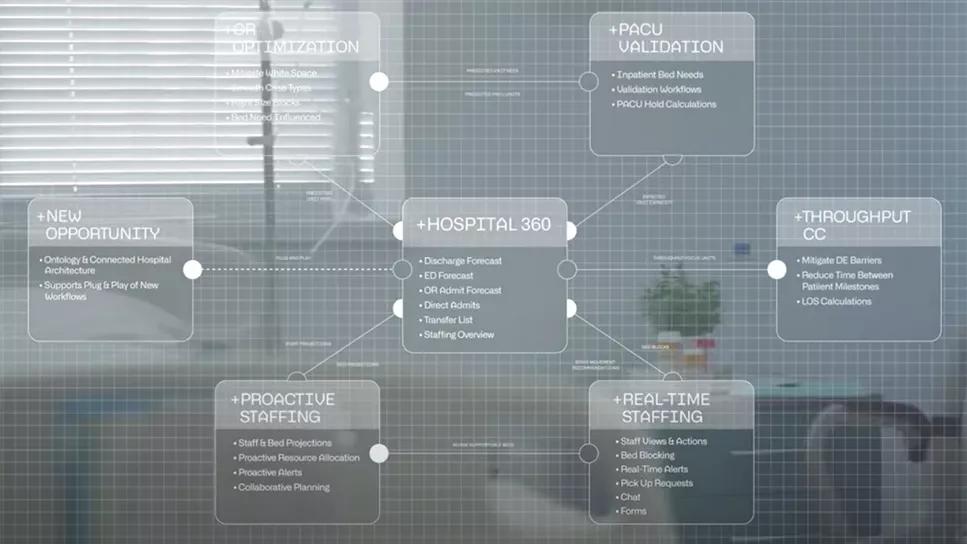Cleveland Clinic partners with Palantir to create logistical command center

To keep Cleveland Clinic running smoothly requires coordination on a massive scale. At the health system’s main campus alone, thousands of patients are admitted, transferred and discharged every day. That requires collection of lots of data. How many open beds are needed? Which beds and operating rooms are available? Are staffing levels appropriate?
Advertisement
Cleveland Clinic is a non-profit academic medical center. Advertising on our site helps support our mission. We do not endorse non-Cleveland Clinic products or services. Policy
A new partnership with Palantir Technologies is making that work more efficient through an artificial intelligence-driven tool called the Virtual Command Center. Palantir is one of the world’s leading companies in integrating artificial intelligence (AI) with big-data analytics.
The Virtual Command Center’s powerful computer interface consists of modules that allow caregivers to view, manage and forecast bed availability, patient demand, staffing and OR scheduling.
“All of these decisions become complex very quickly at the scale at which we operate,” says Rohit Chandra, PhD, Chief Digital Officer. “Working with Palantir, we can now leverage technology to automate and optimize all these decisions.”
The tool does more than organize processes on a virtual platform. It incorporates machine learning and AI capabilities to help predict and adapt to changing stresses.
The Virtual Command Center is one of the first projects to come from Cleveland Clinic’s partnership with Palantir; more are planned. And what develops could have wide-ranging effects.
“Our goal is to transform our hospital operations through technology and, in turn, set the standard for the healthcare industry,” Dr. Chandra says.
Three modules of the Virtual Command Center are currently active.
Advertisement
Hospital 360 and Staffing Matrix work together. Both are in use at main campus as well as at Hillcrest, South Pointe and Euclid hospitals. OR Stewardship is in operation in orthopedic and head and neck departments throughout Ohio.
Hospital 360 and Staffing Matrix allow nurse managers to see bed availability and how many nurses are staffing each unit. The tool provides a campus-wide view of the nursing projections for the shift, week or month, says Nelita Iuppa, ACNO, Nursing Operations. They can see the total number of RNs and support caregivers scheduled, as well as add-ons, call-offs and floats.
Technologies that allow for prioritizing efficiency and informed decision making are essential in healthcare, says Iuppa.
“This project has significantly improved the way that nurse leaders collaborate with the nursing enterprise 24/7 Centralized Staffing Operations team and forecast their needed resources during both routine and peak periods,” she says.
And having this information readily available saves hours. Before they had this technology, managers manually pulled information from multiple sources, says Shannon Pengel, CNO, main campus. “It was very time intensive,” she says. “Now it’s not only quicker, but more accurate.”
Meg Duffy, Senior Director, Staffing & University Outreach in Nursing Operations, agrees.
“It provides all the information in one sharp view,” she says. “Prior to Palantir, it was a laborious process and required multiple phone calls and time 24/7/365 making calls, as well as ad hoc meetings to review and discuss staffing.”
Advertisement
The ability to forecast is key, and having this view is necessary to optimize and efficiently navigate staffing in healthcare today. “Knowing our staffing availability days ahead of time leads to fewer last-minute changes, earlier scheduling and less manual and operational management burden,” says Iuppa.
OR Stewardship is the most recent module to launch. Nathan Mesko, MD, says many variables contribute to creating a successful surgical event.
“The ability to forecast and make predictions (about) how to act based on previous history using AI is huge,” he says. “We’ve never really had objective, evidence-based data looking forward, to predict and quantify forecasts. This will likely become the most powerful attribute of this technology in the future.”
The OR Stewardship module pulls together information that was once collected using Excel files, sticky notes, phone calls and emails.
“The technology helps us find that perfect harmony of matching the right surgery at the right time in the right location with the right surgeon and caregivers, using the right equipment,” says Carol Pehotsky, ACNO, Surgical Services Nursing.
Access to the data ultimately improves patient experience and access. It helps caregivers, too.
“This predictability helps when emergency surgeries come in,” says Pehotsky. “There is less of a fire drill when the unexpected happens. This technology makes the unpredictable more predictable.”
Advertisement
Advertisement

Digital “tripwires” detect and respond to malicious activity, boosting cybersecurity maturity

Thoughtful collaboration, data-driven decisions and effective change management lead to significant savings

Clinical input is integral to technology implementation and adoption strategy

Unit-based project decreases non-urgent alarms

Integrating technology is more than product delivery

Cleveland Clinic’s roadmap to recovering critical digital assets stems from strategic planning and preparedness

The Friends of Cybersecurity program bridges innovative technology solutions with mitigating security risks

Cleveland Clinic’s Information Technology Apprenticeship Program expands skill set while leading to meaningful employment